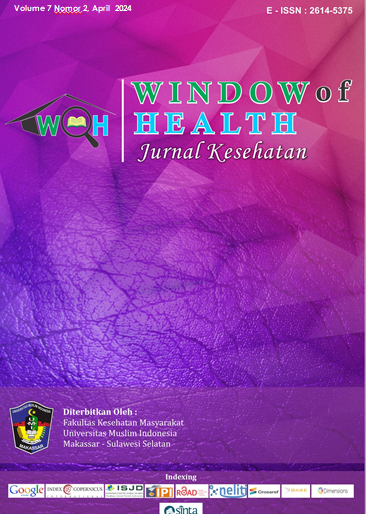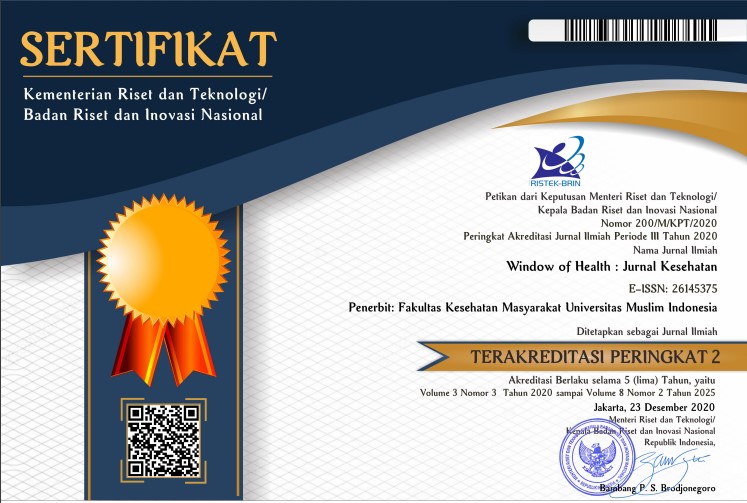The Relationship between Visceral Fat and Cognitive Function in Medical Students
Abstract
During COVID-19, there was a change in student lifestyle, which triggered visceral fat accumulation. The accumulation of visceral fat is one of the causes of systemic inflammation, which is dangerous for the integrity of the brain and can potentially reduce cognitive function. This study aimed to determine the relationship between visceral fat and cognitive function among medical students. This study used a cross-sectional design towards 73 Faculty of Medicine Universitas Pembangunan Nasional “Veteran” Jakarta students who met the criteria and were selected using a simple random sampling technique. The measurement of visceral fat was done using the Tanita Body Composition Analyzer, while the measurement of cognitive function was done using the Digit Symbol Substitution Test questionnaire. The study showed differences in sex and body mass index between normal and high visceral fat groups. There were no differences in age, consumption of junk food, and physical activity between the visceral fat groups. The Spearman test results showed a relationship between visceral fat and cognitive function (p-value equal 0.000; r equal -0.561). The higher the visceral fat, the lower the cognitive function.
References
Papazisis Z, Nikolaidis PT, Trakada G. Sleep, Physical Activity, and Diet of Adults During The Second Lockdown of The COVID-19 Pandemic in Greece. Int J Environ Res Public Health. 2021;18(14).
Wahyuni Y, Dewi R, Utami TP. Upaya Preventif Penyakit Degeneratif Melalui Pemeriksaan Lemak Viseral Masyarakat di Wilayah Pesantren Asshiddiqiyah Jakarta Barat 2017. Jurnal Abdimas.2017;4:280.
Pradana A, Nugroho H.S KH, Puruhita N. Hubungan antara Indeks Massa Tubuh (IMT) dengan Nilai Lemak Viseral. Jurnal Media Medika Muda. 2014;3(1):6–15.
Alwash SM, McIntyre HD, Mamun A. The Association of General Obesity, Central Obesity and Visceral Body Fat with The Risk of Gestational Diabetes Mellitus: Evidence from A Systematic Review and Meta-Analysis. Obes Res Clin Pract [Internet]. 2021;15(5):425–30. Available from: https://doi.org/10.1016/j.orcp.2021.07.005
Raine LB, Khan NA, Drollette ES, Pontifex MB, Kramer AF, Hillman CH. Obesity, Visceral Adipose Tissue, and Cognitive Function in Childhood. Journal of Pediatrics [Internet]. 2017;187:134-140. Available from: http://dx.doi.org/10.1016/j.jpeds.2017.05.023
Syme C, Pelletier S, Shin J, Abrahamowicz M, Leonard G, Perron M, et al. Visceral Fat-Related Systemic Inflammation and The Adolescent Brain: A Mediating Role of Circulating Glycerophosphocholines. Int J Obes [Internet]. 2019;43(6):1223–30. Available from: http://dx.doi.org/10.1038/s41366-018-0202-2
Miller AA, Spencer SJ. Obesity and Neuroinflammation: A Pathway to Cognitive Impairment. Brain Behav Immun [Internet].2014;42:10–21. Available from: http://dx.doi.org/10.1016/j.bbi.2014.04.001
Ozato N, Saitou S, Yamaguchi T, Katashima M, Misawa M, Jung S, et al. Association between Visceral Fat and Brain Structural Changes or Cognitive Function. Brain Sci. 2021;11(8).
Chiba I, Lee S, Bae S, Makino K, Shinkai Y, Shimada H. Visceral Fat Accumulation is Associated with Mild Cognitive Impairment in Community-Dwelling Older Japanese Women. Journal of Nutrition, Health and Aging. 2020;24(3):352–7.
Kemenkes RI. Hasil Riset Kesehatan Dasar Tahun 2018. Kementrian Kesehatan RI. 2018;53(9):1689–99.
Rara Dini MA, Widianti IGA, Wardana ING. Prevalensi Obesitas dengan Menggunakan Metode Waist-Hip Ratio pada Mahasiswa Program Studi Pendidikan Dokter Fakultas Kedokteran Universitas Udayana Angkatan 2014. Bali Anatomy Journal. 2018;1(1):9–11.
Dewi RK, Aisyah WN. Hubungan Indeks Massa Tubuh (IMT) dengan Aktivitas Fisik pada Mahasiswa Kedokteran. Indonesian Journal of Health. 2021;1(2):120–30.
Tchernof A, Després JP. Pathophysiology of Human Visceral Obesity: An Update. Physiol Rev. 2013;93(1):359–404.
Amana DR, Wilson W, Hermawati E. Hubungan Tingkat Aktivitas Fisik dengan Tingkat Depresi Pada Mahasiswa Tahun Kedua Program Studi Kedokteran Fakultas Kedokteran Universitas Tanjungpura. Jurnal Cerebellum. 2021;6(4):94.
Xu Z, Liu Y, Yan C, Yang R, Xu L, Guo Z, et al. Measurement of Visceral Fat and Abdominal Obesity by Single-Frequency Bioelectrical Impedance and CT: A Cross-Sectional Study. BMJ Open. 2021;11(10):1–7.
Luque V, Escribano J, Zaragoza-Jordana M, Rubio-Torrents C, Ferré N, Gispert-Llaurado M, et al. Bioimpedance in 7-Year-Old Children: Validation by Dual X-Ray Absorptiometry - Part 2: Assessment of Segmental Composition. Ann Nutr Metab. 2014;64(2):144–55.
Volkers KM, Scherder EJA. Physical performance is associated with working memory in older people with mild to severe cognitive impairment. Biomed Res Int.2014:18–20.
Murman DL. The Impact of Age on Cognition. Semin Hear [Internet]. 2015;36(3):111–21. Available from: https://www.ncbi.nlm.nih.gov/pmc/articles/PMC4906299/
Miranda M, Morici JF, Zanoni MB, Bekinschtein P. Brain-Derived Neurotrophic Factor: A Key Molecule for Memory in the Healthy and the Pathological Brain. Front Cell Neurosci. 2019;13(August):1–25.
Kemendikbud. Statistik Pendidikan Tinggi (Higer Education Statistic) 2020. PDDikti Kemendikbud [Internet]. 2020;5:81–5. Available from: https://pddikti.kemdikbud.go.id/publikasi
Upadhayay N, Guragin S. Comparison of Cognitive Functions between Male and Female Medical Students: A Pilot Study. Journal of Clinical and Diagnostic Research. 2014;8(6):10–3.
Veit R, Kullmann S, Heni M, Machann J, Häring HU, Fritsche A, et al. Reduced Cortical Thickness Associated with Visceral Fat and BMI. Neuroimage Clin [Internet]. 2014;6:307–11. Available from: http://dx.doi.org/10.1016/j.nicl.2014.09.013
Shah T, Purohit G, Nair SP, Patel B, Rawal Y, Shah RM. Assessment of Obesity, Overweight and Its Association with The Fast Food Consumption in Medical Students. Journal of Clinical and Diagnostic Research. 2014;8(5):5–7.
Reichelt AC, Westbrook RF, Morris MJ. Editorial: Impact of Diet on Learning, Memory and Cognition. Front Behav Neurosci. 2017;11(May):10–1.
Reichelt AC, Rank MM. The Impact of Junk Foods on The Adolescent Brain. Birth Defects Res. 2017;109(20):1649–58.
Keating XD, Zhou K, Liu X, Hodges M, Liu J, Guan J, et al. Reliability and Concurrent Validity of Global Physical Activity Questionnaire (GPAQ): A Systematic Review. Int J Environ Res Public Health. 2019;16(21).
Arida RM, Teixeira-Machado L. The Contribution of Physical Exercise to Brain Resilience. Front Behav Neurosci. 2021;14(January):1–18.
Jeon YK, Ha CH. The Effect of Exercise Intensity on Brain-Derived Neurotrophic Factor and Memory in Adolescents. Environ Health Prev Med. 2017;22(1): 1–6.
Zihl J, Fink T, Pargent F, Ziegler M, Bühner M. Cognitive Reserve in Young and Old Healthy Subjects: Differences and Similarities in A Testing-The-Limits Paradigm with DSST. PLoS One. 2014;9(1).
Anand SS, Friedrich MG, Lee DS, Awadalla P, Després JP, Desai D, et al. Evaluation of Adiposity and Cognitive Function in Adults. JAMA Netw Open. 2022;1–16.
Nguyen JCD, Killcross AS, Jenkins TA. Obesity and Cognitive Decline: Role of Inflammation and Vascular Changes. Front Neurosci. 2014;8(OCT):1–9.
Lampe L, Zhang R, Beyer F, Huhn S, Kharabian Masouleh S, Preusser S, et al. Visceral Obesity Relates to Deep White Matter Hyperintensities via Inflammation. Ann Neurol. 2019;85(2):194–203.
Copyright (c) 2024 Anisa Novita Budiman, Nurfitri Bustamam, Lisa Safira, Feda Anisah Makkiyah

This work is licensed under a Creative Commons Attribution-NonCommercial-ShareAlike 4.0 International License.








